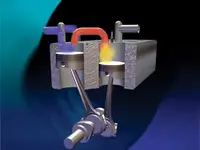Revolutionary Scuderi Engine Significantly Increases MPG Operating in a Nissan Sentra - Video Enhanced, Background Enhanced
 |
Make Me Smarter: Scuderi Engine Background: Stories, Video and Articles
Make Me Smarter: How Scuderi Engine Works - Track180 Video
Make Me Smarter: Nissan Buyer's Guide
WEST SPRINGFIELD, Mass.--Scuderi Group, LLC today released the results of an extensive vehicle computer study (the Study), which was funded by the Scuderi Group and conducted by an internationally recognized, independent research laboratory. The Study modeled various Scuderi Split-Cycle (SSC) engine designs in a vehicle computer model of a 2011 Nissan Sentra.
“These results continue to verify the real-life applicability of our engine design”
The Sentra model was simulated through a standardized Federal Test Procedure-75 (FTP-75) drive cycle for each SSC engine design. Preliminary results of the Study showed that up to a 25 percent decrease in fuel consumption (i.e., up to 33 percent increase in MPG) was achievable with an SSC engine replacing the Sentra’s engine when factoring in fuel cutoff during deceleration and idle in the model. Results also showed that up to 35 percent decrease in fuel consumption (i.e., up to 54 percent increase in MPG) was achievable when compared to the model Nissan Sentra using a stock engine without fuel cutoff.
The primary purpose of the Study was to answer the fundamental question: how much gas mileage will the Scuderi engine achieve? Historically, this has been a difficult question to answer because it is dependent on the type of vehicle the engine is placed in and the route driven (or drive cycle). Scuderi Group commissioned the independent lab to design and implement the computer Study, which could simulate an SSC engine in any vehicle of choice, driven through any drive cycle of choice. Results would then be compared to the same vehicle driven with its factory engine through the same drive cycle. The Nissan Sentra was the first vehicle chosen for the Study, due to its competitive mileage and popularity.
At the onset of the Study, a computer baseline model of the Sentra was established, which closely matched the measured performance of the actual 2011 Nissan Sentra. The lab mounted the Nissan Sentra on a chassis dynamometer and drove the vehicle through the FTP-75 drive cycle to generate the benchmark data. Various SSC engine models were sized to match the acceleration and power of the Sentra’s conventional engine. Each Scuderi engine was then placed into the baseline Sentra vehicle and driven, via computer simulations, through the same FTP-75 drive cycle. Results were compared to the Sentra when operating with its conventional engine. The most favorable results were obtained using a preliminary model of the turbocharged SSC engine with a downsized compression cylinder configured to operate in air-hybrid modes.
“These results continue to verify the real-life applicability of our engine design,” said Sal Scuderi, president of Scuderi Group. “At every step in the development and testing of our engine, we continue to see additional fuel efficiency gains. Our split-cycle configuration is creating the basis for implementing additional propulsion advances that move beyond conventional engine design.”
Automakers are under increased pressure to innovate and bring to market more fuel-efficient cars that can meet stricter fuel economy standards, while providing consumers viable options to contend with rising fuel prices. Scuderi’s fuel-efficient engine designs offer manufacturers a potential solution to address these challenges at lower costs than other alternatives, such as electric hybrids or all-electric vehicles.
Click PLAY to watch the video
Scuderi Group will provide more in-depth details on the results of the Nissan Sentra Study at the Engine Expo 2011 in Stuttgart, Germany, May 17-19. For more information on the Scuderi Engine, visit online at www.ScuderiEngine.com. To hear an audio podcast of Stephen Scuderi, vice president and patent attorney, discussing the Nissan Sentra study, go to Nissan Scuderi Engine Study .
About the Scuderi Engine
The Scuderi Engine divides the four strokes of a combustion cycle between two paired cylinders--the left cylinder functions as an air compressor, handling intake and compression, while the right cylinder handles combustion and exhaust. Key to Scuderi’s split-cycle design is that it compresses the air before it fires. By optimizing the split-cycle concept, the engine when fully developed will reduce NOx emissions up to 80 percent and improve fuel efficiency by 50 percent, compared to a conventional gasoline engine. The engine requires one crankshaft revolution to complete a single combustion cycle and is projected to have higher torque, thermodynamic efficiency, and lower emissions than possible with today’s engines.
About Scuderi Group
Based in West Springfield, Mass., with offices in Frankfurt, Germany, and Nagoya, Japan, Scuderi Group has developed a revolutionary engine technology anticipated to replace many of the standard internal combustion engines used in applications such as cars, trucks, lawnmowers, boats, agriculture equipment, etc. Securing $80M in funding to date, Scuderi Group’s business model is to license its technology to qualified engine manufacturers worldwide. The company’s global patent portfolio contains more than 476 patent applications filed and 154 issued in 50 countries. For more information, please visit Scuderi Engine .
Scuderi, the Corporate logo (also known as the SG Design Mark), SSC and Scuderi Powered are trademarks of Scuderi Group, LLC in the United States. All other trademarks are the property of their respective owners.


